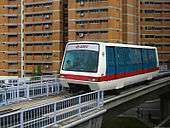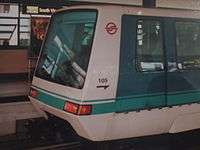Bombardier Innovia APM 100 C801
Bombardier Innovia APM 100 C801
| |||
|---|---|---|---|
|
Interior of Bombardier Innovia APM 100 C801 train. | |||
| In service | 6 November 1999-Current | ||
| Manufacturer |
Adtranz (now Bombardier Transportation) | ||
| Built at | West Mifflin, Pittsburgh, Pennsylvania, United States of America | ||
| Family name | Innovia | ||
| Constructed | 1997-1999 | ||
| Entered service | 1999 | ||
| Number built | 19 Vehicles (19 trainsets) | ||
| Number in service | 19 Vehicles (19 trainsets) | ||
| Formation |
1 per trainset M | ||
| Fleet numbers | 101 - 119 | ||
| Capacity | 22 seated; 83 standing | ||
| Operator(s) | SMRT Trains (SMRT Corporation) | ||
| Depot(s) | Ten Mile Junction | ||
| Line(s) served | Bukit Panjang LRT Line | ||
| Specifications | |||
| Car body construction | Aluminum | ||
| Car length | 12.8 m (41 ft 11 7⁄8 in) | ||
| Width | 2.8 m (9 ft 2 1⁄4 in) | ||
| Height | 3.4 m (11 ft 1 7⁄8 in) | ||
| Doors | 4 per car (2 per side) | ||
| Maximum speed |
55 km/h (34 mph) (design) 48 km/h (30 mph) (service) | ||
| Weight | 15,000 kg (33,000 lb) per car | ||
| Traction system | Bombardier Thyristor control | ||
| Acceleration | 1.0 m/s2 (3.3 ft/s2) | ||
| Deceleration |
1.2 m/s2 (3.9 ft/s2) (service) 1.3 m/s2 (4.3 ft/s2) (emergency) | ||
| Electric system(s) | 600V AC third rail | ||
| Current collection method | Collector shoe | ||
| Safety system(s) | Bombardier CITYFLO 550 ATC with subsystems of ATO GOA 4 (UTO), ATP, ATS and CBI | ||
| Coupling system | Bergische Stahl Industrie | ||
| Track gauge | Central guideway with rubber tyres | ||
Bombardier Innovia APM 100 C801 (APM 100) is an automated people mover (APM) train built by Adtranz (now Bombardier Transportation) for the use on the Bukit Panjang LRT line. These trains are mainly for airport connections and light rail in towns, operating by Automatic Train Control (ATC), making it fully automatic and driverless. The use of rubber tyres and ceramic tracks are extremely quiet compared to conventional rail.
This batch of trains have been operating since 1999 and refurbishments are under planning. If plans go through, it will be the first major overhaul for the C801 train cars. The refurbished train cars will have upgraded air-conditioning and air compressors together with an improved braking system plus installing Close Circuit Televisions (CCTV) under each train car to monitor under the train cars.
Exterior design
The C801 trains are similar to the C801A trains in terms of propulsion motor sound.
- C801 trains have rectangular headlights compared to the C801A trains, which have circular headlights.
- Windscreen and windows are tinted green, but spoilt windows are replaced with a different tint.
- The trains used to bear two turquoise stripes around the train, now replaced by a single red stripe.
Interior design
The C801 trains are similar to the C801A trains in terms of interior looks, other than the color scheme used.
- The seats colour of the trains are green, 4 seats on both ends each and 8 seats in the middle.
- Train Travel Information Systems (TTIS) features an airport shuttle style of look.
- During two car operations, there is no gangway to change from one car to another. The only way is to alight from one car and board the other.
- At each end, the passengers will sit down and view the scenery when the train is on the move.
Livery


Formerly, the livery was under SLRT until 10 May 2004 after the merger of SMRT Corporation. It uses two stripes of turquoise color on green background. In 2005, it changes to a single red stripe. The livery may be subjected to change during refurbishment to the ones similar to C801A and C151B Trains.
Experimental programmes
- Car 101 and 115 were installed with solar windscreen on one of the car ends each. This was to minimize heat and light from entering the trains, which were one of the main causes for warmer trains. The experimental windscreens were only partially successful as the windscreens were not changed out nor rolled out to other train cars.
- The trains used to had 2 LCD displays on each train cars for advertising purposes, but was deactivated around 2009/2010 and removed due to lack of demand.
- Car 116 was installed with the new White headlights used on C801A trains, replacing the existing yellow headlights.
- Car 102 and 119 were installed with CCTVs under the carriage of the train.
Train formation
The configuration of a C801 in revenue service is M
| Car of C801 | ||||||||||
|---|---|---|---|---|---|---|---|---|---|---|
| car type | Motor | Collector Shoe | car length | |||||||
| mm | ft in | |||||||||
| M | ✓ | ✓ | 41 ft 11.9 in | |||||||
The train cars can be coupled up to 2 cars during service.
The car numbers of the trains range from 101 to 119. Individual cars are assigned a three-digit serial number by the rail operator SMRT Trains. A trainset consists of one motor car. For example, set 101 is train 101.
- The first digit is always a 1.
- The second and third digit identifies the train number.
Defects in the C801 rolling stock
After the cracks from the rolling stock C151A trains (That runs on East West Line and North South Line) made public on 5 July 2016 which caused a public uproar (See Operational Problems in C151A), SMRT Trains managing director Lee Ling Wee had also made a press report[1] admitting that C801 trains had also suffered from cracks. According to Lee, the cracks was discovered "during a routine assessment by Bombardier in 2015" and the issue affected all 19 C801 trains. Lee ended by stating that 12 of them have fixed locally using wielding methods with remaining 7 suffered the issue to a less degree are still awaiting for repairs.
Lee did not say what caused the cracks, but a spokesman for Land Transport Authority[1] told Straits Times that the issue is caused by "normal wear and tear" and added that they are not 'safety-critical'. All cracks in C801 trains were found on the "lateral beams of the underframe" and they measured "no more than 12cm"
References
- 1 2 US-made LRT trains also had cracks - Straits Times, 8 July 2016


